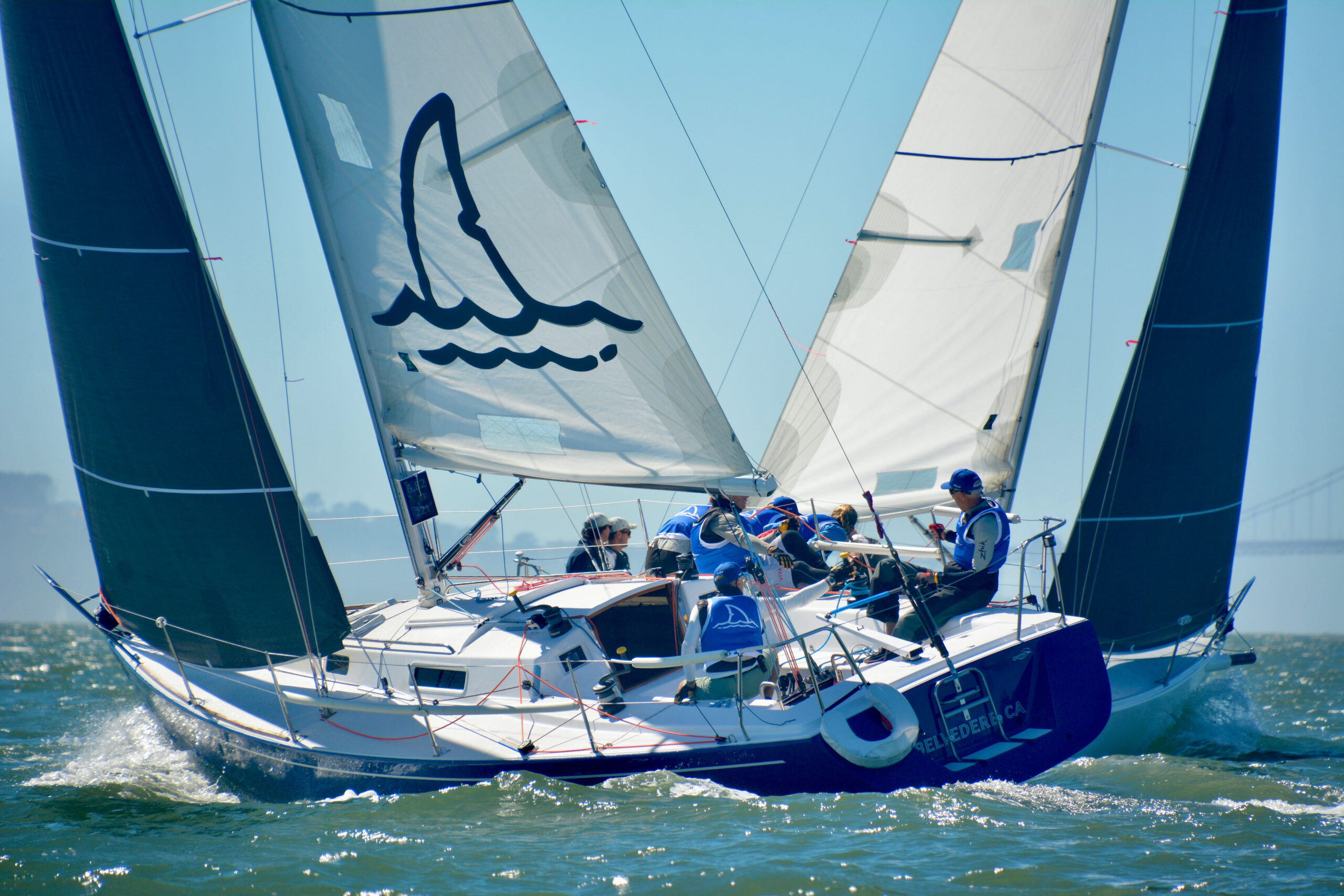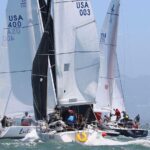|
Boat Speed and Handling Tips:
1. Flat is Fast. – It’s always better to dump the main in puffs to keep your boat on her “feet” than try to pinch into it. A combination of both can be effective as well but as a rule of thumb if your leeward stantion bases are ever in the water you too healed over. Solution is to sail with a looser leech and to play the main sheet rather that the traveler in big breeze and/or puffy conditions.
2. Jibing in big breeze. – We have found it helpful to pull vang on hard prior to jibing. This helps to tighten the leech on the main which in turn reduces the degrees the skipper needs to turn the boat to get the main to come across. After the jibe, remember to let the vang off back to previous spots, as a waiver I won’t take responsibility for broken booms#@$, but if you have the standard/legal amount of purchase on the vang this shouldn’t be an issue in big breeze. Try this when the breeze is strong, it’s very effective in combination with the “S” turn jibe.
3. Getting ready to start the next race after we finish the last. – This is the classics “do as we say not as we do”. I can not count how many times we have been caught eating sandwiches and cookies way away from the line with we realize we have 4 minutes to start. With the new starting system it is now important to start the set up for race 2 immediately after race 1. Only after we are ready to race will we get awarded with food.
4. Big picture tactics. – Making tactical decisions that back up the below strategies: Get a clean lane: Good clean lanes are not easy to get in big fleets. Fight for them and stay in them. The smaller the race course the more this rule oft thumb is applicable. When picking a lane, think not only about what it looks like at that moment but what it will look like in 3,5,8..minutes.
5. Minimize tacking: – These boats (J105’s) loose a chunk when you tack, especially in breeze and bump, Lee bowing a starboard tacker can equal two extra tacks, When deciding to waive a port tacker or force them to tack we mainly look at their lane to see if it’s a good one, considering both wind shifts and clean air.
Zuni Bear is in second place 1 point behind Good Timin’ going into the BBS. Zuni has won 7 races and numerous regattas including the NOOD and Summer Keel.
Preparing the Rig for the onslaught of another season can take time but will pay in results. – This offseason I pulled the standing rigging for inspection after four years of hard San Francisco sailing and found it needed some attention. The paint had been weathered a bit and had lost its luster, the spreaders looked like wings that had just flown through an ice storm. The forstay was kinked at the upper section of the furler because the inside spacer had dropped and the aluminum was chafing the rod and peeling away. Both the forestay and the uppersection of the foil were replaced. All other points were in good working order.
The mast, spreader and boom, were disassembled piece by piece, labeled, and prepared for a new paint job. I did some of the sanding prep but left most of the finishing for Art Puett and his crew at Nelson Marine, my long time trusted friends.
The reassembly and tuning was something left to Glen Hansen and his crew at Hansen Rigging. We tuned to factory and Sail loft specs. A generous layer of McLube Sailkote on all surfaces. We ran the Jib halyard to starboard and the Main to port. This allows better upwind tension and pointing ability, since the lewmar and or spinnlock cleats slip so much we now can wrap each on a separate secondary winch and leave them tight for up wind adjustment. I upgraded to the Ronstan turnbuckle system for the Cap Shrouds and the D1s and left the D2s standard. These systems have been approved since 2001 and allow better reference when tuning. I haven’t touched it since Glen and crew placed the settings. Which are Caps at 41, D1s at 31, and D2s at hand tight. The forstay is about set in the middle of the minimum and maximum settings.
There should be no doubt that constant inspection and maintenance are essential factors to consistent performance. Our aggressive Bay conditions will take their toll on equipment overtime. Overall though, I am satisfied with the endurance of the equipment and a bit surprised with its minimal wear and tear.
Bella Rosa has 2 bullets this year and won the 2002 J Fest with a 1,3,3,4 total of 11 points.
BACK TO TOP
|
 San Francisco J/105 Fleet #1
San Francisco J/105 Fleet #1




